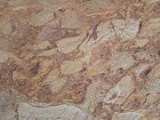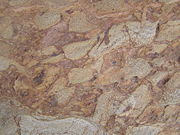
Mélange
Encyclopedia

Geology
Geology is the science comprising the study of solid Earth, the rocks of which it is composed, and the processes by which it evolves. Geology gives insight into the history of the Earth, as it provides the primary evidence for plate tectonics, the evolutionary history of life, and past climates...
, a mélange is a large-scale breccia, a mappable body of rock characterized by a lack of continuous bedding and the inclusion of fragments of rock of all sizes, contained in a fine-grained deformed matrix. The mélange typically consists of a jumble of large blocks of varied lithologies. Large-scale melanges formed in active continental margin settings generally consist of altered oceanic crust
Oceanic crust
Oceanic crust is the part of Earth's lithosphere that surfaces in the ocean basins. Oceanic crust is primarily composed of mafic rocks, or sima, which is rich in iron and magnesium...
al material and blocks of continental slope sediment
Sediment
Sediment is naturally occurring material that is broken down by processes of weathering and erosion, and is subsequently transported by the action of fluids such as wind, water, or ice, and/or by the force of gravity acting on the particle itself....
s in a sheared mudstone
Mudstone
Mudstone is a fine grained sedimentary rock whose original constituents were clays or muds. Grain size is up to 0.0625 mm with individual grains too small to be distinguished without a microscope. With increased pressure over time the platey clay minerals may become aligned, with the...
matrix
Matrix (geology)
The matrix or groundmass of rock is the finer grained mass of material in which larger grains, crystals or clasts are embedded.The matrix of an igneous rock consists of finer grained, often microscopic, crystals in which larger crystals are embedded. This porphyritic texture is indicative of...
. The mixing mechanisms in such settings may include tectonic shearing forces, ductile flow of a water-charged or deformable matrix (such as serpentinite
Serpentinite
Serpentinite is a rock composed of one or more serpentine group minerals. Minerals in this group are formed by serpentinization, a hydration and metamorphic transformation of ultramafic rock from the Earth's mantle...
), sedimentary action (such as slumping, gravity-flow, and olistostromal action), or some combination of these. Some larger blocks of rock may be as much as 1 km across. Smaller-scale localized melanges may also occur in shear or fault zones, where coherent rock has been disrupted and mixed by shearing forces.
Examples include the Franciscan Formation along the Coast Ranges of central and northern California
California
California is a state located on the West Coast of the United States. It is by far the most populous U.S. state, and the third-largest by land area...
and the Bay of Islands
Bay of Islands, Newfoundland and Labrador
The Bay of Islands is an extensive inlet located on the west coast of the island of Newfoundland, in Canada. The Way Office was established on July 1, 1883. The first Waymaster was Thomas Carter.It is also a sub-basin of the Gulf of St...
ophiolite complex in Newfoundland
Newfoundland and Labrador
Newfoundland and Labrador is the easternmost province of Canada. Situated in the country's Atlantic region, it incorporates the island of Newfoundland and mainland Labrador with a combined area of . As of April 2011, the province's estimated population is 508,400...
. The Gwna Mélange in the UK extends through Anglesey
Anglesey
Anglesey , also known by its Welsh name Ynys Môn , is an island and, as Isle of Anglesey, a county off the north west coast of Wales...
and the Llŷn Peninsula
Llŷn Peninsula
The Llŷn Peninsula extends into the Irish Sea from north west Wales, south west of the Isle of Anglesey. It is part of the modern county and historic region of Gwynedd. The name is thought to be of Irish origin, and to have the same root Laigin in Irish as the word Leinster...
onto Bardsey Island in North Wales. The Northern Palawan melange distributed in Minilog Island, west coast of Inabamalaki Island, west coast of El NIdo town; Cudugman Point on Bacuit Bay, in the islands of the Cuyo Group of Islands. It consists of a jumble of various rock types contained in a matrix of grey-green slaty mudstone and siltstone.
Before the advent of plate tectonics
Plate tectonics
Plate tectonics is a scientific theory that describes the large scale motions of Earth's lithosphere...
in the early 1970s, it was difficult to explain mélanges in terms of known geological mechanisms. A particularly troubling paradox was the occurrence of blueschist blocks (low temperature and high pressure metamorphic rocks) in direct contact with graywacke (a coarse sandstone with lithic fragments) that was deposited in a sedimentary environment. Mélange occurrences are associated with thrust fault
Thrust fault
A thrust fault is a type of fault, or break in the Earth's crust across which there has been relative movement, in which rocks of lower stratigraphic position are pushed up and over higher strata. They are often recognized because they place older rocks above younger...
ed terranes in orogenic
Orogeny
Orogeny refers to forces and events leading to a severe structural deformation of the Earth's crust due to the engagement of tectonic plates. Response to such engagement results in the formation of long tracts of highly deformed rock called orogens or orogenic belts...
belts. A mélange is formed in the accretionary wedge
Accretionary wedge
An accretionary wedge or accretionary prism is formed from sediments that are accreted onto the non-subducting tectonic plate at a convergent plate boundary...
above a subduction zone. The ultramafic ophiolite sequences which have been obducted
Obduction
Obduction is the overthrusting of continental crust by oceanic crust or mantle rocks at a convergent plate boundary. It can occur during an orogeny, or mountain-building episode....
onto continental crust
Continental crust
The continental crust is the layer of igneous, sedimentary, and metamorphic rocks which form the continents and the areas of shallow seabed close to their shores, known as continental shelves. This layer is sometimes called sial due to more felsic, or granitic, bulk composition, which lies in...
are typically underlain by a mélange. Both tectonic and sedimentary processes can form mélange. Olistostrome
Olistostrome
The term olistostrome is derived from olio - a dish of many ingredients or stew; a mixture of heterogeneous elements; hodgepodge. and stroma - a bed covering...
s are mélanges formed by gravitational sliding under water, with accumulation of the flow as a semi fluid body without bedding
Bed (geology)
In geology a bed is the smallest division of a geologic formation or stratigraphic rock series marked by well-defined divisional planes separating it from layers above and below. A bed is the smallest lithostratigraphic unit, usually ranging in thickness from a centimeter to several meters and...
planes.
Etymology
The term mélange in English languageEnglish language
English is a West Germanic language that arose in the Anglo-Saxon kingdoms of England and spread into what was to become south-east Scotland under the influence of the Anglian medieval kingdom of Northumbria...
is a loan word from French
French language
French is a Romance language spoken as a first language in France, the Romandy region in Switzerland, Wallonia and Brussels in Belgium, Monaco, the regions of Quebec and Acadia in Canada, and by various communities elsewhere. Second-language speakers of French are distributed throughout many parts...
, used to mean mixture of disparate components (what would be referred to in the science
Science
Science is a systematic enterprise that builds and organizes knowledge in the form of testable explanations and predictions about the universe...
s as a heterogeneous mixture). Its derivation, and therefore to some extent its connotation, is similar to Mêlée
Mêlée
Melee , generally refers to disorganized close combat involving a group of fighters. A melee ensues when groups become locked together in combat with no regard to group tactics or fighting as an organized unit; each participant fights as an individual....
http://www.etymonline.com/index.php?search=melange&searchmode=nonehttp://www.etymonline.com/index.php?search=melee&searchmode=none. Mélange is the modern form of the Old French
Old French
Old French was the Romance dialect continuum spoken in territories that span roughly the northern half of modern France and parts of modern Belgium and Switzerland from the 9th century to the 14th century...
noun meslance, which comes from the infinitive
Infinitive
In grammar, infinitive is the name for certain verb forms that exist in many languages. In the usual description of English, the infinitive of a verb is its basic form with or without the particle to: therefore, do and to do, be and to be, and so on are infinitives...
mêler, meaning "to mix".

